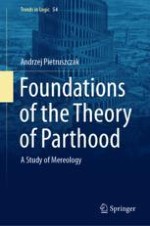2020 | OriginalPaper | Buchkapitel
2. “Existentially Neutral” Theories of Parts
verfasst von : Andrzej Pietruszczak
Erschienen in: Foundations of the Theory of Parthood
Aktivieren Sie unsere intelligente Suche, um passende Fachinhalte oder Patente zu finden.
Wählen Sie Textabschnitte aus um mit Künstlicher Intelligenz passenden Patente zu finden. powered by
Markieren Sie Textabschnitte, um KI-gestützt weitere passende Inhalte zu finden. powered by

